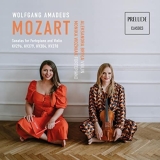Von Mozarts vierzig Sonaten und Variationszyklen für Klavier und Violine plus laut Köchel-Verzeichnis sieben separaten Sätzen haben die Musikerinnen Aleksandra Bryla und Monika Wozniak vier ausgewählt, die zu seinen schönsten gehören. Die Musikerinnen spielen auf Nachbauten zeitgenössischer Instrumente, also auch einem Fortepiano.
Von einem ständigen Vorwärtsstreben beseelt erobern sich die beiden Instrumentalistinnen die Sonaten. Selbst in den langsamen Sätzen gehen sie voran und vertrödeln sich nicht. Das bietet einen ständigen Fluss an Musik. Dabei geben sie der Entwicklung aber auch die Räume, sie auszuformen und zu gestalten. Mit frischer Lesart, die eher das Lebensbejahende zeigt als vielleicht auch denkbare Probleme, streichen sie den angenehmen Charakter der Musik heraus. Dabei zeigen sie auch kleine und feine Aspekte der Werke, ohne die Betrachtungen der Details über Gebühr zu forcieren. So schaffen sie positiv nach vorn blickende Interpretationen, die keine unnötigen Schatten werfen und so das ohnehin angenehme Wesen dieser Werke unterstreichen.
Die randvoll gepackte CD wurde vom Aufnahmeteam in einem nahen und kristallinen Stil eingefangen, der die Musik unmittelbar nahe bringt, ohne sich zu sehr aufzudrängen. Das Beiheft mit allgemeinen Worten zu den Sonaten von Mozart und Einzelbetrachtungen sowie Hinweisen zu den Künstlerinnen runden das Bild ab.
From Mozart’s forty sonatas and variation cycles for piano and violin plus, according to the Köchel catalog, seven separate movements, the musicians Aleksandra Bryla and Monika Wozniak have chosen four that can be heard as belonging to his most beautiful. The musicians play on replicas of contemporary instruments, including a fortepiano.
The two instrumentalists conquer the sonatas with a constant striving forward. Even in the slow movements, they move forward and don’t dawdle. This provides a constant flow of music. Yet they also give the development the spaces to shape and form it. With fresh readings that show the life-affirming rather than perhaps conceivable problems, they emphasize the pleasant character of the music. In doing so, they also show small and subtle aspects of the works without unduly forcing the consideration of the details. In this way, they were unnecessarily fragmenting the cohesion in the sections.
In this way, they create positively forward-looking interpretations that do not cast unnecessary shadows, underscoring the already pleasant nature of these works. This is a jam-packed CD, captured by the recording team in a close and crystalline style that brings the music immediately close without being too intrusive. The booklet, with general words on Mozart’s sonatas and individual reflections as well as notes on the artists, completes the picture.






















